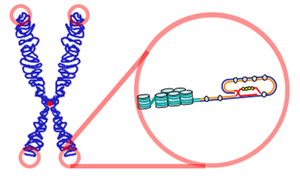Telomeres are bits of noncoding DNA that cap the ends of our chromosomes like tassels. Because of the way DNA is replicated, each time a chromosome is copied a bit of the end is lost. That's not a problem as long as it's just the tassel that gets docked. Eventually, though, you run out of tassel and then the cell can no longer divide properly.

Drawing of a telomere at the end of a chromosome.
The researchers found that the shortened telomeres in the LPs were associated with greater amounts of DNA damage at the ends of chromosomes. Thus, the short telomeres might be markers for tumor-causing DNA damage.
The shortening of telomeres isn’t irreversible, there’s an enzyme called ‘telomerase’ that lengthens them. LPs also had higher levels of telomerase than other types of breast tissue, no doubt to compensate for their malfunctioning telomeres. However, the telomerase activity declined with increasing age.
The authors created the following graphic to explain their results and their speculations.
At the top is one type of breast cell shown in blue (a primitive basal mammary cell) with normal telomeres. Beneath it is a luminal progenitor cell (shown in red) with short telomeres. You can see that the amount of active telomerase varies with the age of the patient. Finally, at the bottom are possible paths the LP can take. It can exit the cell cycle (die), differentiate (become a mature luminal cell) or grow into a tumor.
Obviously, this work is in the early stages. We don’t yet know how telomere length fits into the whole tumorigenesis picture. It’s just one more piece of the puzzle but one that may be worth playing with.

Beneath it is a luminal progenitor cell (shown in red) with short telomeres. You can see that the amount of active telomerase varies with the age of the patient. Finally, at the bottom are possible paths the LP can take. - See more at: http://stochasticscientist.blogspot.com/2013/07/adding-telomeres-to-breast-cancer.html#sthash.weLjYP5e.dpuf
ReplyDeleteGold für WOW KaufenGold On Runescape
Good summary of this study. Your description of the complex findings makes it easier to understand for everyone. Thanks.
ReplyDeleteThank you!
ReplyDelete